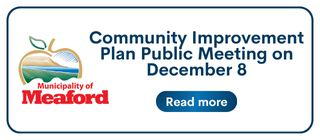By Stephen Vance, Staff
 It is no secret that for all levels of government, voter turnout has been on the decline in recent years. In the last municipal election, which was held in October of 2010, voter participation in Meaford reached the lowest level since the 2001 amalgamation, with just 50 percent of eligible voters casting a ballot.
It is no secret that for all levels of government, voter turnout has been on the decline in recent years. In the last municipal election, which was held in October of 2010, voter participation in Meaford reached the lowest level since the 2001 amalgamation, with just 50 percent of eligible voters casting a ballot.
Not that previous elections had been much better. In 2000, voter turnout was 53 percent, in 2003, 51 percent of eligible voters cast ballots, and in 2006, 55 percent.
Provincially, Ontario hit an all-time low for voter turnout in the 2011 provincial election with barely more than 49 percent of eligible voters finding their way to the polls.
Many factors contribute to voter participation, and pollsters have dedicated much time trying to determine what makes the modern voter tick. And while voter apathy, lacklustre candidates, or an absence of galvanizing issues are often cited as factors which help to keep voters at home on election day, another issue is often mentioned – convenience for voters.
This week, Meaford’s council has given initial approval to a potential solution to the issue of convenience – electronic voting.
The municipality has used a mail-in paper ballot for recent municipal elections, and while that has been a relatively cost effective, and practical method for a large rural community with a relatively small population given its geographical size, the time has come to find a better way, and electronic voting just might be the ticket to improving voter participation on election day.
Allowing voters to cast their ballots electronically, from the comfort of their home, office, cottage, or while away on vacation, would certainly eliminate the excuse by an eligible voter that they can’t fit voting into their busy schedule.
The model presented to Meaford’s council will use a combination of telephone and online voting, a system that the municipal Clerk says will save approximately $25,000 in election costs. The projected cost for next year’s municipal election is estimated to be $80,000 if the current mail-in paper ballot is used, while electronic voting will cost $55,000.
Voters would be able to cast a ballot over an 11 day period, and votes would be counted electronically.
According to a report presented to council by the Clerk, 44 municipalities in Ontario used electronic voting either exclusively, or as part of their voting options in the 2010 municipal election. It was noted in the report that the Township of Brockton who used electronic voting exclusively in 2010, saw a voter participation rate of 59 percent.
While a move to electronic voting can be seen as a positive development in municipal elections, it is a move that Meaford should make with caution.
As with any voting system, things can go wrong, and they have with electronic voting – Huntsville for example had issues in 2010 with voters not receiving their PINs and voting instructions in advance of the election, and Arnprior had to extend their voting period by 24 hours after a high volume of voters logging onto the system caused a hardware issue as a result of the load on their server.
What will be critical for a smooth transition to electronic voting is communication and education on the part of the municipality.
Meaford will need to be as vigilant as possible in communicating the change to voters, and they will need to hold public information sessions throughout the municipality to inform people how their vote will be cast, how it will be counted, and how the accuracy of the vote can be assured.
Not only that, the municipality must give voters confidence in the new system by ensuring that any and all questions about electronic voting are answered fully, and communicated publicly – even questions about potential problems. A simple “everything will be fine” is not good enough when you are talking about a voter’s ballot. Anything the municipality claims about a new electronic voting system must be explained in clear language, and backed up with facts and hard data wherever necessary.
Glitches (and there have been plenty of issues with the traditional paper ballots as well), and the need to ensure proper promotion and education is provided to voters aside, a move by municipalities to embrace modern technology on election day, should be seen as a move in the right direction.
The Clerk’s report says that not only will an electronic voting system cost significantly less, it will require minimal staff time in order to hold an election, it will eliminate the potential for spoiled ballots, it will speed up delivery of results on election day, and those results will be more accurate than traditional voting methods.
When you can save money, have a more accurate vote count, and possibly attract more eligible voters by making casting a ballot more convenient for them, that is positive change, and Meaford staff and council should be applauded for taking this initiative.










